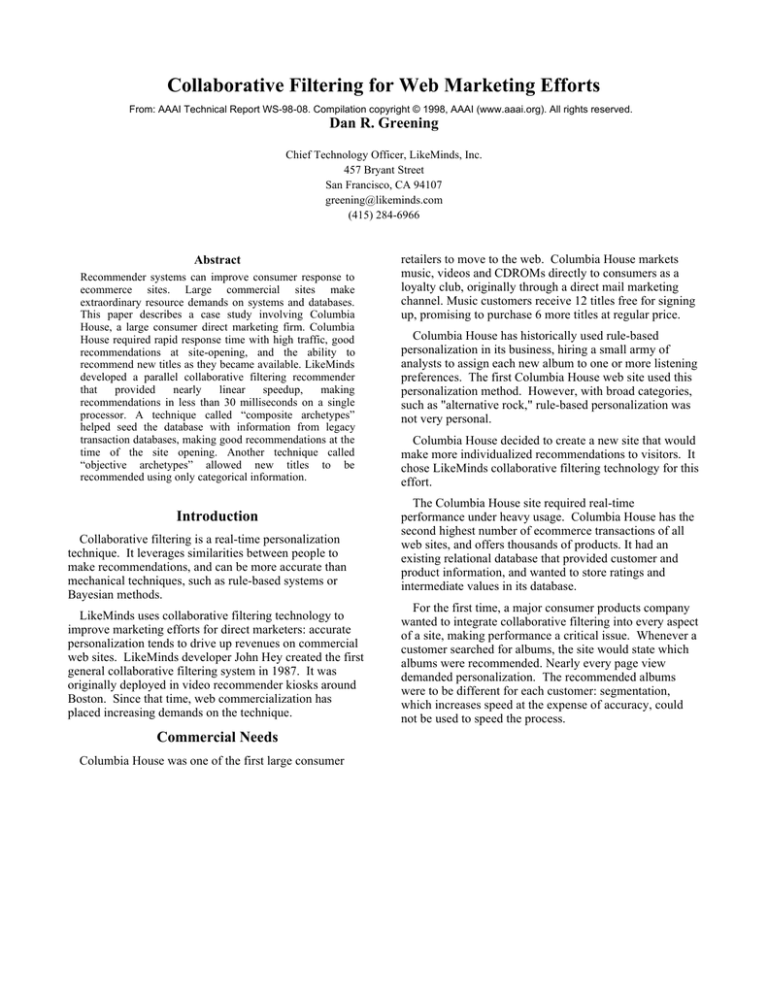
Collaborative Filtering for Web Marketing Efforts
From: AAAI Technical Report WS-98-08. Compilation copyright © 1998, AAAI (www.aaai.org). All rights reserved.
Dan R. Greening
Chief Technology Officer, LikeMinds, Inc.
457 Bryant Street
San Francisco, CA 94107
greening@likeminds.com
(415) 284-6966
Abstract
Recommender systems can improve consumer response to
ecommerce sites. Large commercial sites make
extraordinary resource demands on systems and databases.
This paper describes a case study involving Columbia
House, a large consumer direct marketing firm. Columbia
House required rapid response time with high traffic, good
recommendations at site-opening, and the ability to
recommend new titles as they became available. LikeMinds
developed a parallel collaborative filtering recommender
that
provided
nearly
linear
speedup,
making
recommendations in less than 30 milliseconds on a single
processor. A technique called “composite archetypes”
helped seed the database with information from legacy
transaction databases, making good recommendations at the
time of the site opening. Another technique called
“objective archetypes” allowed new titles to be
recommended using only categorical information.
Introduction
Collaborative filtering is a real-time personalization
technique. It leverages similarities between people to
make recommendations, and can be more accurate than
mechanical techniques, such as rule-based systems or
Bayesian methods.
LikeMinds uses collaborative filtering technology to
improve marketing efforts for direct marketers: accurate
personalization tends to drive up revenues on commercial
web sites. LikeMinds developer John Hey created the first
general collaborative filtering system in 1987. It was
originally deployed in video recommender kiosks around
Boston. Since that time, web commercialization has
placed increasing demands on the technique.
Commercial Needs
Columbia House was one of the first large consumer
retailers to move to the web. Columbia House markets
music, videos and CDROMs directly to consumers as a
loyalty club, originally through a direct mail marketing
channel. Music customers receive 12 titles free for signing
up, promising to purchase 6 more titles at regular price.
Columbia House has historically used rule-based
personalization in its business, hiring a small army of
analysts to assign each new album to one or more listening
preferences. The first Columbia House web site used this
personalization method. However, with broad categories,
such as "alternative rock," rule-based personalization was
not very personal.
Columbia House decided to create a new site that would
make more individualized recommendations to visitors. It
chose LikeMinds collaborative filtering technology for this
effort.
The Columbia House site required real-time
performance under heavy usage. Columbia House has the
second highest number of ecommerce transactions of all
web sites, and offers thousands of products. It had an
existing relational database that provided customer and
product information, and wanted to store ratings and
intermediate values in its database.
For the first time, a major consumer products company
wanted to integrate collaborative filtering into every aspect
of a site, making performance a critical issue. Whenever a
customer searched for albums, the site would state which
albums were recommended. Nearly every page view
demanded personalization. The recommended albums
were to be different for each customer: segmentation,
which increases speed at the expense of accuracy, could
not be used to speed the process.
8VHU UDWLQJVDPSOH
:HE
6HUYHU
3UHGLFWRU
5LQJ %XIIHU
&DFKH
0HQWRU ,GHQWLILHU
8VHU UDWLQJVDPSOH
:HE
6HUYHU
3UHGLFWRU
5LQJ %XIIHU
&DFKH
0HQWRU ,GHQWLILHU
D :HE ,QWHUIDFH
E 'LVWULEXWHG 'DWDEDVH
F 0HQWRU ,GHQWLILFDWLRQ
EDFNJURXQG
)LJXUH 3DUDOOHOLVP LQ 3UHIHUHQFH 6HUYHU close to linear in both cases.
Parallel Collaborative Filtering
Leveraging Legacy Data
To satisfy these constraints, LikeMinds created a parallel
processing model with a high degree of scaleability, as
shown in Figure 1. Database locking was virtually
eliminated by separating mentor matching processes from
prediction vector construction processes. Multithreading
was used throughout to keep long database requests from
interfering with short prediction computations. Columbia
House initially deployed the system on four networked
UNIX processors. Later, LikeMinds moved its own
demonstration site, MovieCritic, to a symmetric
multiprocessor running UNIX. Performance scaling is
I WK
H&
RO R
6WD
UEO
QG
LQG
NHQ
2Q
L
Q
J
$Q
V
$Q
WKU
RS
0 LJ
UDLQ RORJL
VW R
H
Q0
3D
XO %
DUV
URF
D (
-DP
[SO
HV
R
3D
UNLQ UHU RI
,Q 6
VRQ
WKH
HD
UFK
%UD
RI
LQ
&K
XUF
KLOO
+D
Columbia House wanted to make good
recommendations as soon as the site opened to the public.
Like many direct marketers, Columbia House had a wealth
of information about the past buying behavior of its
customers. LikeMinds built a system to cluster these
customers and aggregated them into "rating vectors" for
hypothetical consumers, called "composite archetypes."
LikeMinds used these archetypes to seed the rating
database, successfully recommending albums from day
one.
WHG
,W
5HO ,WHP
HYD
QFH
ZHL
J
$Z
D
98 \HDU
98 VXEMHFW
QHXURORJ\
98 VXEMHFW
ELRJUDSK\
6PLWK
-RQHV
:HVVRQ
-RQ
6P
LWK
5HDO 8VHUV
0HQWRUV
HV
:H
VVR
Q
98
DX
WKR
U 2
98
O LYH
SX
EOLV
U6
DFN
KH
98
U
V
\HD
+D
USH
U U
98
VXE
MHF
98
W Q
HXU
VXE
RO R
MHF
J\
W E
LRJ
UDS
K\
WR
ODQ
GR
+DUSHU
HJ
H ,V
2OLYHU 6DFNV
98 SXEOLVKHU
$/
98 DXWKRU
7K
9LUWXDO 8VHUV
KW
%RRNV
)LJXUH *HQHUDWLQJ 5HFRPPHQGDWLRQV IURP 2EMHFWLYH )DFWRUV
Columbia House wanted to recommend new products
immediately. Straight collaborative filtering cannot
recommend a product until someone rates it. To resolve
this, LikeMinds used a variation of rule-based
personalization, shown in Figure 2, to adaptively
recommend products by category, artist, or listening type,
creating hypothetical consumers who like everything
satisfying a selection criteria. We call these hypothetical
consumers "objective archetypes". A system seeded with
objective archetypes adapts as users rate or buy new
products, moving from rule-based predictions to more
accurate behavior based predictions.
Although it may seem that collaborative filtering has
matured, LikeMinds customers continue to make
unforeseen demands on the technology, motivating
innovative solutions.



